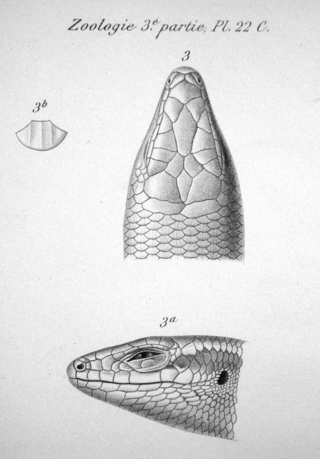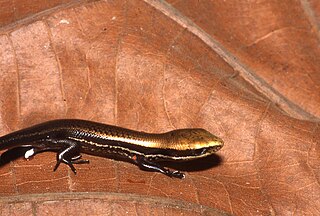Plasmodium minasense is a parasite of the genus Plasmodium subgenus Carinamoeba.

Trachylepis is a skink genus in the subfamily Mabuyinae found mainly in Africa. Its members were formerly included in the "wastebin taxon" Mabuya, and for some time in Euprepis. As defined today, Trachylepis contains the clade of Afro-Malagasy mabuyas. The genus also contains a species from the Brazilian island of Fernando de Noronha, T. atlantica, and may occur in mainland South America with Trachylepis tschudii and Trachylepis maculata, both poorly known and enigmatic. The ancestors of T. atlantica are believed to have rafted across the Atlantic from Africa during the last 9 million years.
Two-striped mabuya may refer to either of two small skink species formerly placed in the genus Mabuya:

The Noronha skink is a species of skink from the island of Fernando de Noronha off northeastern Brazil. It is covered with dark and light spots on the upperparts and is usually about 7 to 10 cm in length. The tail is long and muscular, but breaks off easily. Very common throughout Fernando de Noronha, it is an opportunistic feeder, eating both insects and plant material, including nectar from the Erythrina velutina tree, as well as other material ranging from cookie crumbs to eggs of its own species. Introduced predators such as feral cats prey on it and several parasitic worms infect it.

Trachylepis maculata, the spotted mabuya, is a species of skink in the genus Trachylepis recorded from Demerara in Guyana, northern South America. It is placed in the genus Trachylepis, which is otherwise mostly restricted to Africa, and its type locality may be in error. It is an unstriped, olive-brown, grayish animal, with dark spots all over the body. Its taxonomic history is complex due to confusion with Trachylepis atlantica from the Atlantic Ocean island of Fernando de Noronha and doubts regarding its type locality.

The Dominican ground lizard or Dominican ameiva is a species of lizard. It is endemic to the Caribbean island of Dominica, an island noted for its intact and abundant reptile population, where it is most commonly found in dry coastal woodland.
Trachylepis tschudii is an enigmatic skink, purportedly from Peru. First described in 1845 on the basis of a single specimen, it may be the same as the Noronha skink (T. atlantica) from Fernando de Noronha, off northeastern Brazil. T. tschudii represents one of two doubtful records of the otherwise African genus Trachylepis on mainland South America; the other is T. maculata from Guyana.

The Greater Martinique skink is a species of skink found on Martinique. It has shiny, bronze-colored skin, with a pair of light stripes that run along its upper flanks.

Chioninia vaillantii, also known commonly as Vaillant's mabuya or Vaillant's skink, is a species of skink in the family Scincidae. The species is endemic to the Cape Verde Islands. There are two recognized subspecies.
Medetera bistriata is a species of longlegged fly in the family Dolichopodidae. It is widely distributed in North America, spanning from the pine forests of boreal Canada south to Honduras, and it is common in the pine forests of the Atlantic and Gulf costal plains. The larvae are predators of bark beetles in the genera Dendroctonus and Ips, and have been noted as important predators of the southern pine beetle, Dendroctonus frontalis.

Varzea is a genus of skinks.

Miniopterus sororculus is a species of bat endemic to the highland forests of Madagascar.

Mabuyinae is a subfamily of lizards, commonly known as skinks, within the family Scincidae. The genera in this subfamily were previously found to belong the Mabuya group in the large subfamily Lygosominae.

Parawixia bistriata is a spider species found mainly in South America. It is known to have social foraging behavior. Due to its complex social system, it can live in habitats with various resource levels. Recently, its social behavior has been well-studied. Also, this species can collectively change its web structure in response to changes in prey type. They live collectively in web systems and thrive in both dry and wet climates. The size of its body is very small, typically 2 cm (0.8 in) long.












